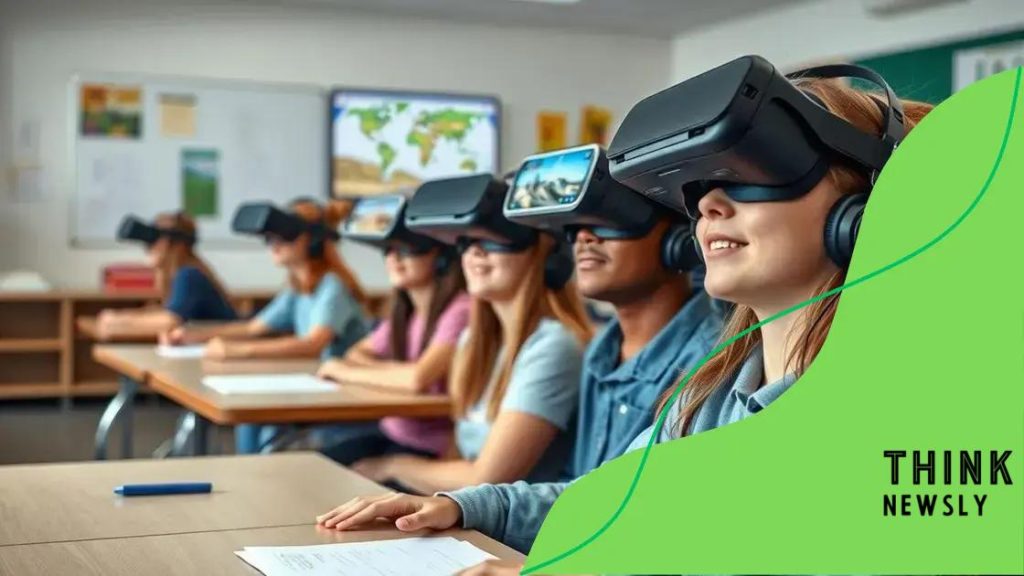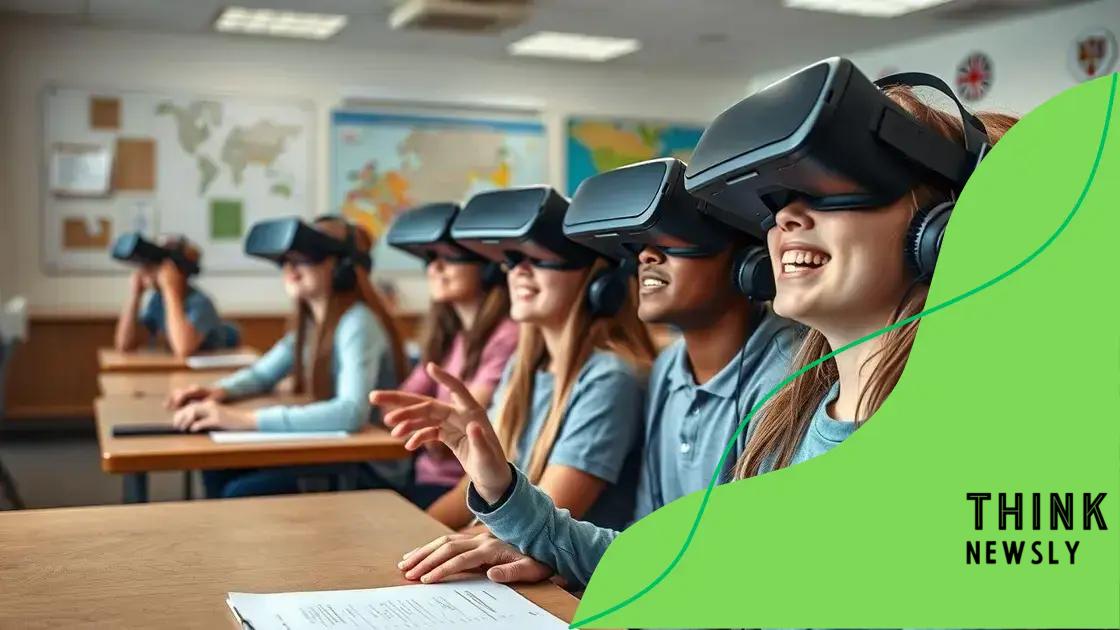Field trips include virtual reality experiences for learning

Anúncios
Virtual reality in education enhances learning by providing immersive experiences, fostering collaboration, personalizing lessons through AI, and expanding subject coverage to include science, history, art, and language learning.
Field trips include virtual reality as a game-changer in education. Imagine exploring ancient Rome or diving into the ocean without leaving your classroom. This innovative approach not only enhances learning but also makes it more engaging and accessible.
Anúncios
Understanding virtual reality in education
Understanding virtual reality in education is essential in today’s learning environment. It offers students a unique way to experience lessons that would be impossible or impractical in the real world. Imagine taking a field trip to historical landmarks or exploring the depths of the ocean without leaving the classroom.
This technology allows students to immerse themselves in different environments, making learning more engaging and interactive. They can visualize complex concepts in a 3D space, leading to a deeper understanding of the material.
Benefits of Virtual Reality in Learning
By incorporating virtual reality into educational settings, teachers can enhance traditional teaching methods. Here are some key benefits:
Anúncios
- Improved engagement and motivation.
- Enhanced retention of information.
- Safe exploration of dangerous or inaccessible environments.
- Opportunities for collaborative learning.
When students actively participate in their education, it promotes better retention of knowledge. For example, a biology student can interact with a virtual cell, which makes the learning experience more memorable than just reading from a textbook.
Challenges to Consider
While virtual reality has many advantages, there are also challenges to address. These include the cost of technology and the need for teacher training. It’s crucial for schools to consider these factors when implementing VR programs.
Additionally, not all subjects may benefit equally from this technology. Educators must assess whether VR aligns with their curriculum objectives.
Despite the challenges, the potential for enhancing educational experiences is substantial. As technology advances, the accessibility of virtual reality in education will likely improve, paving the way for a more interactive learning environment.
Benefits of virtual reality field trips
Exploring the benefits of virtual reality field trips can unveil how this technology transforms traditional educational experiences. Students can learn in a more engaging way while practicing essential skills that apply to the real world. These immersive experiences captivate attention, making lessons unforgettable.
One significant advantage is the ability to visit places that are otherwise unreachable. Students can experience ancient ruins, deep-sea environments, or even outer space—all from a classroom. This not only enhances their understanding but also inspires curiosity.
Engagement and Interaction
Virtual reality enhances student engagement by allowing them to interact directly with content. Instead of passively listening, they can participate actively. This interaction can lead to:
- Higher motivation levels during lessons.
- Improved collaboration among classmates.
- Stronger connections to the subject matter.
- Opportunities to explore multiple perspectives on a topic.
The hands-on approach encourages students to ask questions and explore scenarios in a safe environment. For example, a student learning about ecosystems can explore a rainforest virtually. They can see various species, understand their interactions, and grasp the concept of biodiversity in a way that feels real.
Cost-Effectiveness and Accessibility
Another benefit of virtual reality field trips is their cost-effectiveness. Traditional field trips often involve transportation, entry fees, and meal costs. In contrast, virtual trips can provide similar experiences at a fraction of the cost.
This accessibility allows more schools to offer field trips. Schools in remote areas can provide their students the same learning opportunities as those in urban settings. By reducing costs and logistical challenges, VR opens the door for broader educational experiences.
Ultimately, the benefits of virtual reality field trips are far-reaching. They not only make learning more exciting but also make it possible for every student to experience educational adventures that enrich their knowledge and skills.
How to integrate virtual reality into school trips

Integrating virtual reality into school trips can significantly enhance the learning experience. This technology allows students to explore topics in depth while fostering engagement and curiosity. By creatively using VR, educators can make lessons unforgettable.
The first step in this integration is to choose the right technology. Schools should look for reliable VR headsets and educational platforms that offer immersive content. Many programs provide virtual tours of historical sites, natural wonders, and scientific explorations. Once the right tools are in place, teachers can easily plan trips that enrich their curriculum.
Planning the Virtual Experience
When planning a virtual reality experience, it’s essential to align the trip with classroom objectives. Here are some important factors to consider.
- Identify learning goals for the trip.
- Choose VR content that complements those goals.
- Ensure all students have access to the necessary technology.
- Provide training for teachers on how to use the VR tools effectively.
This careful planning can lead to more meaningful educational opportunities. For example, a history teacher might select a virtual tour of Ancient Egypt that supports the material covered in class. As students navigate through the pyramids and temples, they can engage with content in a way that feels real.
Engaging Students
Virtual reality also opens up new avenues for student engagement. Teachers can encourage students to interact with the VR environment and participate in guided activities, such as quizzes or discussion prompts. This interactivity helps solidify understanding as students apply their knowledge in a practical, immersive setting.
After the virtual trip, discussions can deepen the learning experience. Teachers can organize group reflections on what students learned and how it relates to their studies. By allowing students to share their insights, they help reinforce the knowledge gained during the experience.
Integrating virtual reality into school trips can turn ordinary lessons into extraordinary explorations. With thoughtful planning, educators can create enriching experiences that leave lasting impressions on their students.
Examples of successful virtual reality implementations
Many schools and institutions have successfully implemented virtual reality (VR) to enhance learning. These examples showcase how VR can transform education and make lessons more interactive and memorable.
One notable example is the use of VR in science education. Schools have introduced programs that allow students to explore the human body in 3D. By using VR, students can walk through the circulatory system or examine organs up close. This immersive experience provides a unique understanding of anatomy that textbooks simply cannot offer.
Historical Immersion
Another success story comes from history classes that use VR to transport students back in time. For instance, students can virtually visit ancient civilizations such as Rome or Egypt. They can interact with historical figures and witness important events firsthand.
- Students can explore the Colosseum during a gladiator match.
- Walk the streets of ancient Alexandria, learning about its rich culture.
- Experience the construction of pyramids alongside the workers.
This kind of engagement allows students to connect with history in a deeper way, making events and cultures feel real and relevant to their studies.
Language Learning through VR
Virtual reality is also making waves in language instruction. Programs that use VR can place students in scenarios where they must communicate in a foreign language. For example, students might join a virtual market where they practice ordering food or negotiating prices with vendors.
This immersive environment helps learners to practice their language skills contextually, rather than through traditional drills. By engaging in realistic conversations, students build confidence and improve their speaking abilities faster than conventional methods allow.
These successful implementations of virtual reality in various educational settings demonstrate its potential to enrich the learning experience. By embracing this technology, educators can inspire students and foster a love for learning that lasts a lifetime.
Future trends of virtual reality in education
The future of virtual reality in education looks promising, as advancements in technology continue to enhance learning experiences. With the integration of artificial intelligence and improved VR hardware, the possibilities for education will expand significantly.
One trend is the personalization of learning experiences. As virtual reality becomes more widely used, it will incorporate AI to adapt lessons to individual student needs. This means lessons can be tailored to each student’s pace and learning style, making education more effective.
Collaborative Learning Environments
Another trend is the creation of collaborative VR environments. Students from different locations can join the same virtual classroom to work on projects together. This collaboration will help foster teamwork and communication skills, which are essential in today’s world.
- Virtual group projects where students can share ideas in real-time.
- Interactive discussions led by instructors who guide students through VR resources.
- Global classrooms that connect diverse groups of learners.
Such environments will prepare students for future workplaces that increasingly rely on remote teamwork.
Expansion of Subject Areas
Virtual reality is set to become a significant tool across various subject areas, not just in science and history. Fields like art and music will also benefit from immersive experiences, where students can create and perform in virtual settings.
For example, students in an art class can learn painting techniques by collaborating with virtual artists or attending galleries in real-time. This exposure to different fields can cultivate creativity and innovation among students.
As these trends develop, the potential for virtual reality in education is boundless. Schools and educators who embrace these technologies will significantly enhance the learning experience, preparing students for a future that values adaptability and collaboration.
In summary, the integration of virtual reality in education will continue to grow and evolve. As technology advances, students will benefit from more personalized and interactive learning experiences. Schools that embrace these innovations will not only enhance engagement but also help students develop essential skills needed for the future. By exploring subjects in immersive environments, learners can connect with the material on a deeper level. The future of education is bright with the promise of virtual reality.
FAQ – Frequently Asked Questions about Virtual Reality in Education
How can virtual reality enhance the learning experience?
Virtual reality can create immersive experiences that engage students, making lessons more interactive and memorable.
What are the benefits of collaborating in virtual reality?
Collaboration in VR allows students from different locations to work together in real-time, fostering teamwork and communication skills.
How does AI integrate with virtual reality in education?
AI can personalize virtual reality lessons to suit individual learning styles and paces, making education more effective.
In what subjects can virtual reality be used?
Virtual reality can be applied across various subjects, including science, history, art, and language learning, providing diverse educational experiences.





